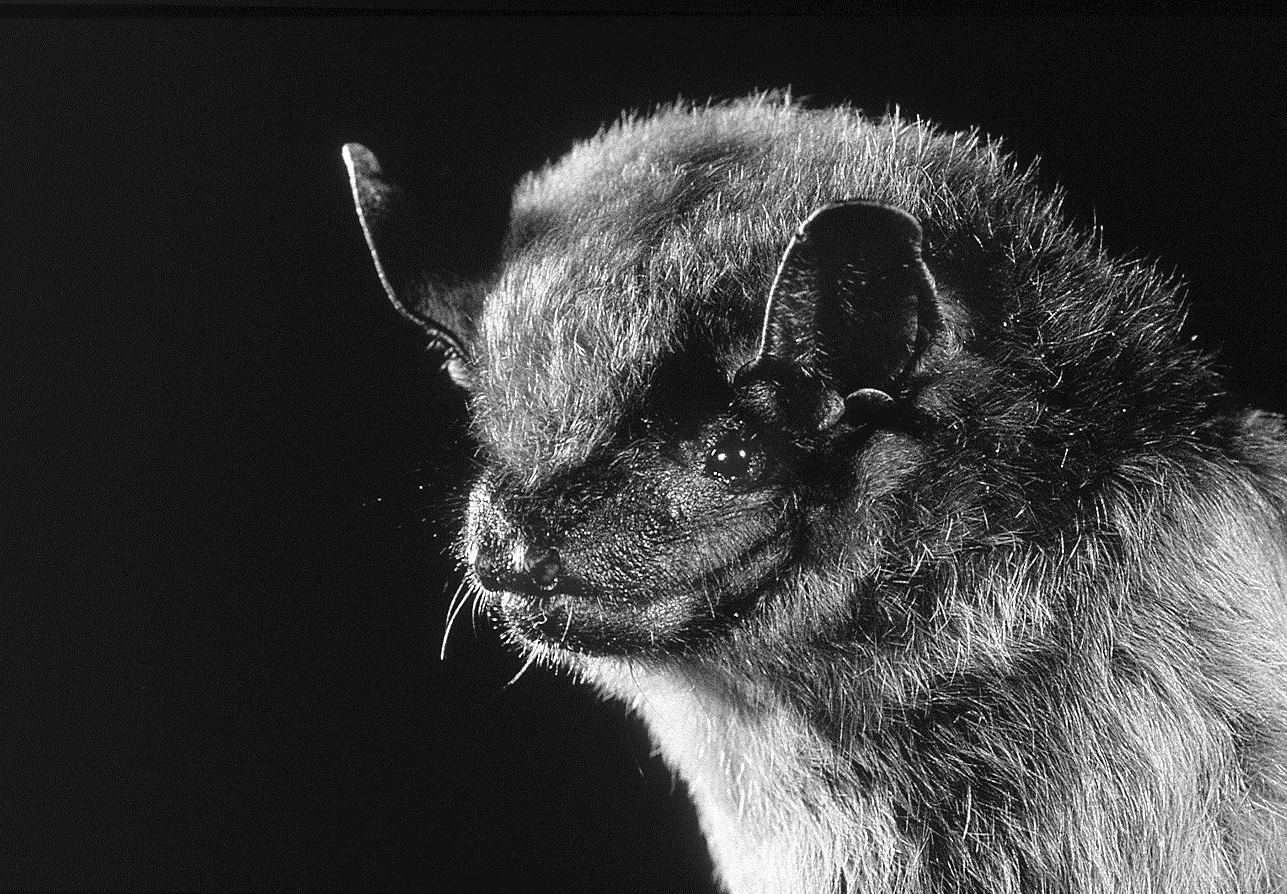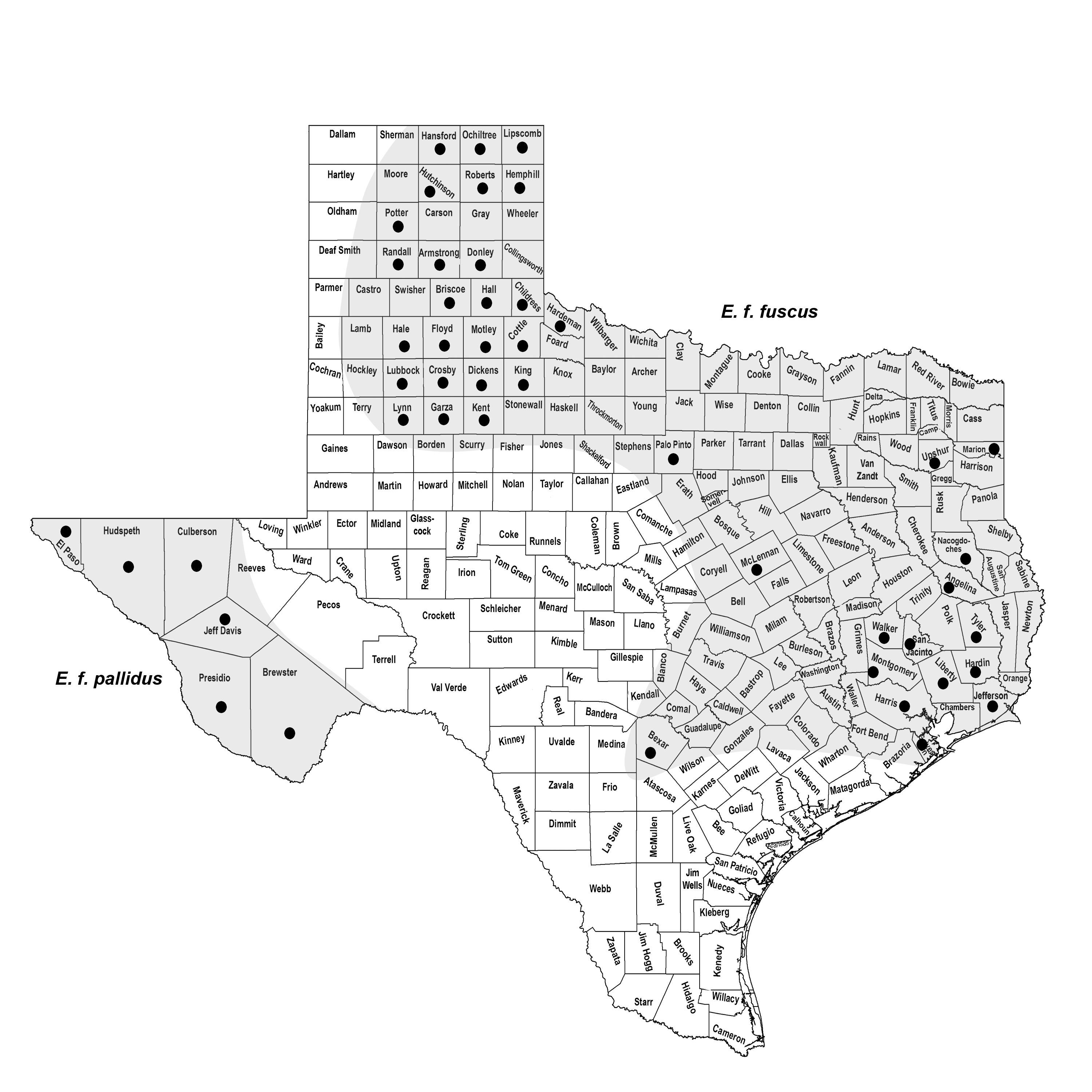BIG BROWN BAT
Eptesicus fuscus (Palisot de Beauvois 1796)
Order Chiroptera : Family Vespertilionidae
DESCRIPTION. A medium-sized bat with upperparts rich chestnut brown; ears relatively small, thick, leathery, and black; membranes blackish; underparts paler than back; ears and membranes devoid of hair, or nearly so; wing short and broad, length of fifth metacarpal almost equal to that of third. Dental formula: I 2/3, C 1/1, Pm 1/2, M 3/3 × 2 = 32. Averages for external measurements: total length, 114 mm; tail, 46 mm; foot, 11 mm; forearm, 47 mm. Weight, 13–20 g, rarely to 30 g.

DISTRIBUTION. The big brown bat is distributed throughout the United States except for the extreme southern tip of Florida. It has a somewhat disjunct distribution in Texas, having been recorded primarily from the eastern, northern, and western parts of the state with few specimens available from the central and southern parts. The eastern and western forms are regarded as different subspecies and may differ in reproductive habits as discussed below.

SUBSPECIES. Eptesicus f. fuscus in the eastern and northern portions of the range and E. f. pallidus in the wooded, mountain areas of the Trans-Pecos region.
HABITS. This species is normally a forest dweller, but it does not hesitate to utilize attics and crevices in buildings, caves, and crevices in rocks for daytime retreats. Favorite roosts are under the loose bark of dead trees and in cavities of trees. These bats emerge rather early in the evening and feed among the trees, often following a regular route from one treetop to another and back again. In contrast to eastern red bats (Lasiurus borealis), big brown bats prefer to forage among the crowns of the trees rather than under the forest canopy. Their flight is relatively slow and direct.
Big brown bats are relatively ferocious when captured. They usually squeal when handled and produce a rapid ratchet-like sound; they continually try to bite and usually draw blood when they succeed in doing so. They cannot produce a serious wound, however. In the water they swim well, but they cannot take off from the surface as can some of the smaller bats (Myotis and Parastrellus spp.). In winter, they migrate or seek hibernation quarters in caves or buildings.
Their food is entirely insects, which they capture in flight. Fecal pellets of these bats have shown that they feed on beetles, bees and their allies, flies, stoneflies, mayflies, true bugs, net-wings, scorpionflies, caddisflies, and cockroaches. Peculiarly, moths are seldom found. Food items vary, of course, from one region to another.
These bats mate in the fall, and the one or two young are born from May to August. Four embryos have been found in a female, but it is unlikely that they all would have survived because the mother has only two teats. Big brown bats in the eastern part of the United States usually produce two young per litter, whereas in the Rocky Mountains and westward only one young is produced. Texas spans both of these ranges with bats from the Trans-Pecos having one young, and those from the High Plains, Rolling Plains, and Pineywoods producing twins. Specimens from the Panhandle appear to be intermediate between the two subspecies, giving birth to two young like fuscus but being pale in coloration like pallidus.
At birth, the young bats weigh about 3 g and grow quickly, gaining as much as 0.5 g per day. Maternity colonies are often located in buildings and may contain from 20 to 300 individuals. Adult males usually are not present in maternity colonies until the young mature, when they may begin using maternity colonies more frequently. At 4 weeks of age, the young bats begin foraging for themselves and reach adult size approximately 2 months after birth.
Their known predators include barn owls, great horned owls, and black snakes. Big brown bats are long-lived and survival in excess of 10 years is not uncommon.
POPULATION STATUS. Common, year-round resident. The big brown bat is a year-round resident and is common over most of its range in Texas.
CONSERVATION STATUS. This species' status is listed as least concern by the IUCN because of its wide distribution, presumed large population, occurrence in a number of protected areas, and tolerance to some degree of habitat modification. The big brown bat is not included on the federal or state lists of concerned species, and there are no known threats to its status in Texas at this time.
From The Mammals of Texas, Seventh Edition by David J. Schmidly and Robert D. Bradley, copyright © 1994, 2004, 2016. Courtesy of the University of Texas Press.
Natural Science Research Laboratory
-
Address
Museum of Texas Tech University, 3301 4th street, Lubbock, TX 79409 -
Phone
806.742.2486 -
Email
nsrl.museum@ttu.edu

